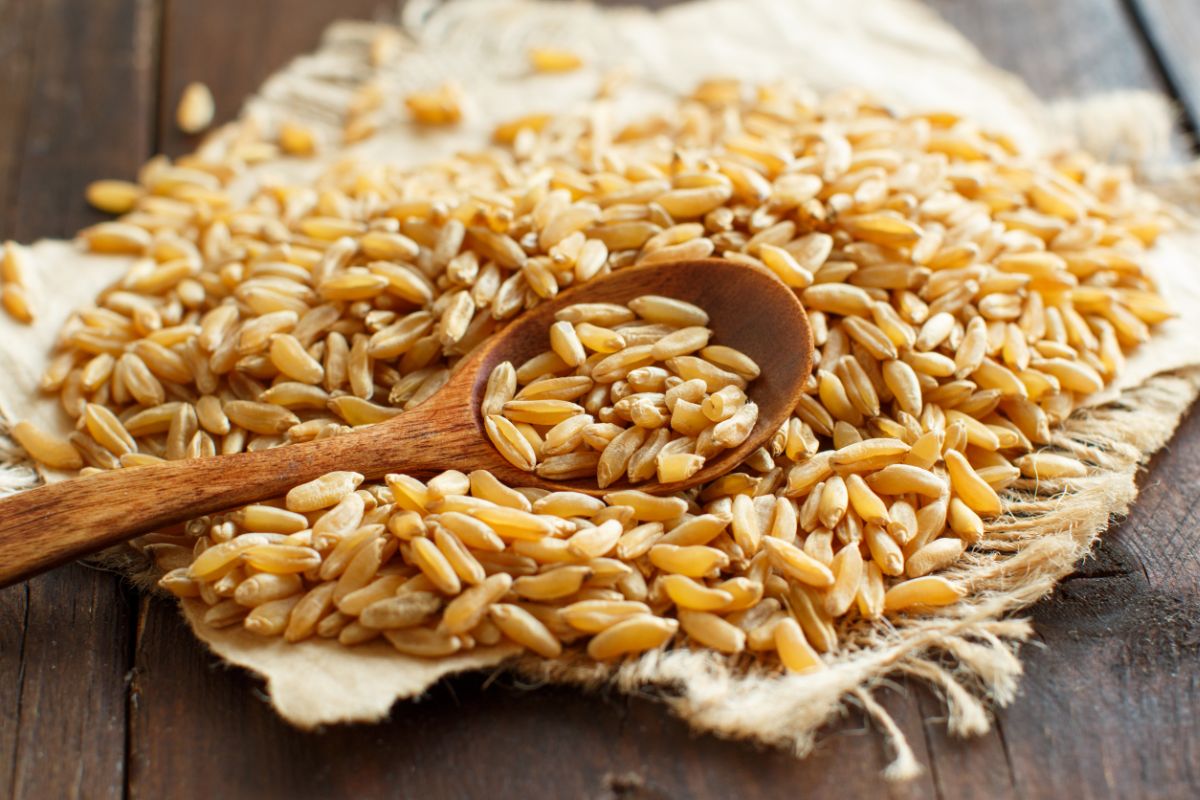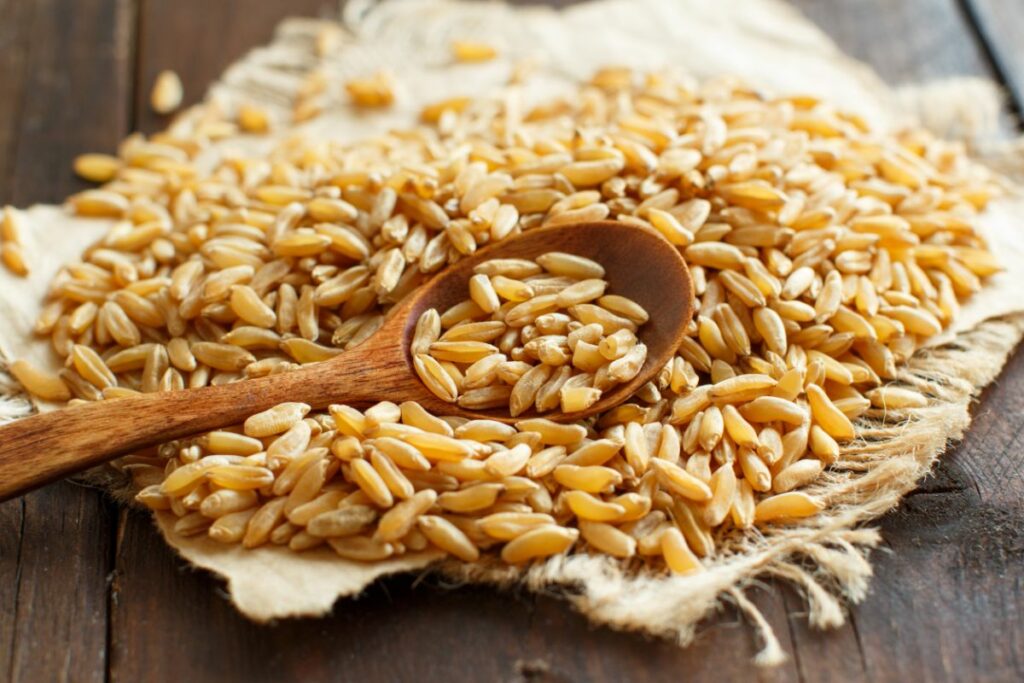In recent years, the craze of ancient grains has led to the popularization of barley, quinoa and millet. But what about Kamut?

Well, the question should really be ‘what about khorasan wheat?’, as Kamut is actually the brand name which khorasan wheat is sold under.
Over time, Kamut has become a genericization of khorasan wheat.
Kamut (pronounced ka-moot) as a brand is located in Montana and is the sole producer of this specific strain of khorasan wheat.
This strain is non-hybridized, meaning that any khorasan wheat sold by Kamut is organically grown and is the same as it would have been thousands of years ago.
What Is Khorasan Wheat
Khorasan wheat is an ancient grain that is similar to modern wheat, only it is twice the size. It has a distinct hunch-back shape and has a rich, golden color.
The history of khorasan wheat isn’t exactly known and it has acquired many nicknames based on the legends of its history.
One story is that it was discovered in an ancient Egyptian tomb giving it the nickname ‘Pharaoh’s grain’ or ‘King Tut’s wheat’.
Another story is that it was brought on Noah’s ark giving it the name ‘Prophet’s wheat’. You know a grain is old when there are myths about its origin.
What Does It Taste Like
It has been described as having a nutty and buttery taste.
Due to its size it also holds its shape really well in liquid broths without becoming mushy.
In fact khorasan wheat has a deliciously chewy texture.
Due to its buttery taste, khorasan wheat has been gaining popularity in the baking world. It has been praised as giving a rich flavor which can’t be replicated by regular wheat.
Benefits
When compared to regular wheat, khorasan wheat has 30% more protein. It also has more amino acids providing all 8 of them.
Khorasan wheat is high in vitamins, fiber and lipids which are needed for high energy. We see no reason for khorasan wheat to not be incorporated into your diet.
Khorasan wheat does contain gluten so it is not ideal for people with celiac disease, but some people who are gluten sensitive have said that khorasan wheat is easier on the stomach.
As A Grain
Like other grains, khorasan wheat can be consumed whole. It makes a delicious substitute for rice and works well in grain salads and pilaf.
Due to its large size it makes a great addition to any liquidy dishes, such as soups, stews and chili.
Khorasan wheat is a popular grain amongst the vegetarian and vegan community because of its high protein content.
When compared to other grains, it makes an efficient replacement for the nutritional value that comes from meat.
As Flour
Any recipe that calls for whole wheat flour, you can 100% replace it with khorasan flour.
It gives a glorious buttery taste to any baked goods and works wonderfully in bread.

However if you are planning on making bread with it then be warned, you may need to use slightly more water in order to get a consistent dough.
As well as bread, khorasan flour can be used to make all sorts of foods such as cookies, pancakes, and muffins.
It has even gained a passionate community amongst certain pasta makers, for its desirable flavor.
As Beer
Just like other wheats, khorasan wheat can be used to make home-brew beer. It creates a deliciously malty finish that works wonders after a long work week.
How To Cook It
It is recommended that you soak your khorasan wheat overnight before cooking it.
This is because soaking it reduces the cooking time, khorasan grains are relatively large so they take a long time to cook.
Unlike other grains, it is recommended that you cook your khorasan grain similar to how you would cook pasta.
In order to cook them you need a 3:1 ratio of water to khorasan wheat. First, bring the mixture to a boil before turning it down to a medium heat.
You then need to cook your khorasan wheat until it is soft. This will typically take about 45 minutes, 75 minutes if you don’t soak them.
Once they are tender then you can drain the excess water from the pot. Other grains will call for all the water to be absorbed, this is not the case for this ancient grain.
Slow Cooker
For those who like to cook their food in a slow cooker, then khorasan wheat is the grain for you.
All you have to do is place a 6:1 ratio of water to khorasan wheat in the slow cooker and cook on medium for 5-6 hours, or on high for 3 hours.
Once it is soft then you can just drain any excess water before serving.
What Flavors Work Well With Khorasan Wheat
- Carrots
- Onion
- Asparagus
- Spinach
- Pork
- Lamb
- Sweet Potato
- Pumpkin
- Coffee
- Coconut
- Dark chocolate
Due to the rich nature of khorasan wheat, it works particularly well with the warming spices of the colder seasons.
This doesn’t mean that you can’t enjoy it in the summer months in a hearty salad, or even baked into some delicious lemon bars.
Khorasan wheat is a truly versatile grain that can work year round. The health benefits of it is only overshadowed by its delicious flavor.
How To Store It
Similar to other grains, khorasan wheat should be stored in an airtight container in a dark place.
Ideally, you should keep it in the refrigerator. If you do however then it is key that the container is airtight as khorasan wheat readily absorbs moisture.
Conclusion
Khorasan wheat is not nearly as common as it deserves to be. It is high in protein and nutrients and can give any recipe a rich twist.
Incorporating this ancient grain into your diet isn’t something you will regret.








